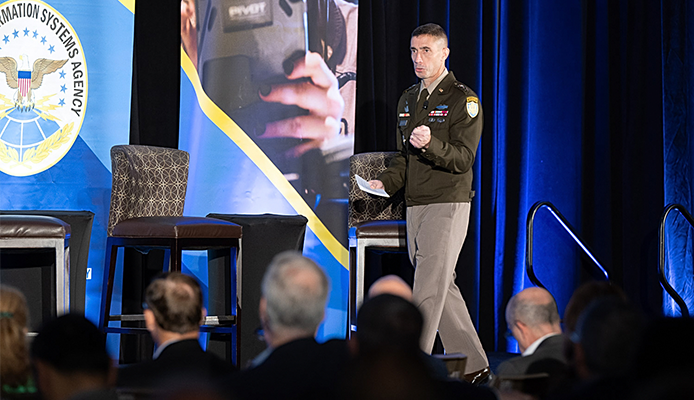‘We have to be postured for continuous change’ declares DISA director
By Marco A. Villasana Jr., DISA Office of Strategic Communication and Public Affairs
October 28, 2024

Army Lt. Gen. Paul T. Stanton, JFHQ-DODIN commander and DISA director, speaks at Forecast to Industry 2024. (DISA photo by Edward Cannon)
“Seven seconds — seven seconds is how long it takes Russian artillery to be inbound onto Ukrainian position,” warned Army Lt. Gen. Paul T. Stanton, Joint Force Headquarters – Department of Defense Information Network commander and Defense Information Systems Agency director.
Stanton used that example in his opening remarks at DISA’s Forecast to Industry 2024 event to stress the need for rapid, data-driven decision-making on the battlefield.
“When we give U.S. commanders decision space, we will fight and win,” he said, adding, “Making a better and faster decision than our enemies is central to how we execute.”
Throughout his speech, Stanton reiterated that success on the modern battlefield hinges on delivering the right data to the right place at the right time, cautioning that, unlike civilian industries, the agency operates under life-and-death conditions.
“We have heavy dependency on commercial technology, thought, innovation, drive [and] the products that you provide, but fundamentally, what distinguishes our requirement to support the Warfighter is that the enemy is trying to kill us,” Stanton exclaimed.
“Everything that we do is tied back to the Warfighter. If it's not tied back to the Warfighter, then why are we as a combat support agency doing it?”
Addressing the rapid pace of technological change, Stanton underscored the need for continuous modernization, urging industry partners to develop solutions that are adaptive and capable of evolving alongside emerging technologies. He emphasized the need for “ruthless prioritization” to eliminate outdated technology, asking, “How do we leap ahead? Frankly, I’m tired of dragging everything behind us.”
In addition to technical agility, Stanton called for intuitive design, particularly for systems used by Warfighters operating under incredible stress and horrible conditions with very little time to operate.
“It’s got to work when it’s 32 degrees, pouring rain and 0200,” he said. “32 degrees is the most miserable time for wet weather. Lived it in the past. Your hands don’t function properly. You lose the dexterity in your fingers. It’s got to be simple and intuitive, and you’ve got to be able to operate at speed.”
He likened the design principles needed for military systems to the simplicity with which children interact with modern devices.
“Watch your kids or your grandkids swiping up and down and left and right — it’s intuitive. They know how it works,” he said. “We have to do our job; we have to do it well; failure is not an option. Warfighting depends on it. Our service members, our civilians [and] our contractor force have to sit down in front of the piece of equipment with confidence that they know how it works.”
Beyond technology, Stanton focused on the value of teamwork, urging industry partners to see themselves as part of DISA’s mission.
“Warfighting is the ultimate team sport,” said Stanton. “We want you to be part of our team. We need you to be part of our team … When you contract with us, you’re part of the team.”